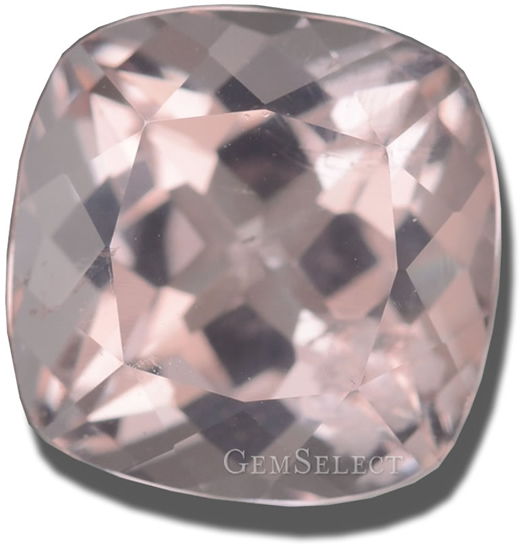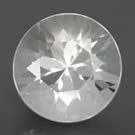Morganite Gemstone Information

About Morganite - History and Introduction
Morganite, with its delicate shades of pink and peach, is a gemstone that has gained popularity in recent years for its elegance and romantic appeal. Named after the American banker and gem enthusiast J.P. Morgan, who was an avid collector of gemstones, morganite gemstone belongs to the beryl family, alongside emerald and aquamarine. Its soft, pastel hues range from pale pink to peach to salmon, evoking a sense of tenderness and femininity. To dive deeper into its fascinating background, learn more about morganite’s history.
Pink morganite was first identified in Madagascar in 1910 and was initially known as 'pink beryl'. Shortly after, George F. Kunz, a renowned American gemologist and buyer for Tiffany & Company, renamed it in honor of John Pierpont (J.P.) Morgan, an American banker and avid gemstone collector. Since its discovery, morganite stone has been prized by gem collectors due to its rarity. If you're looking to add one to your collection, explore stunning morganite gemstones available.
Identifying Morganite
Morganite is an aluminum beryllium silicate. Its color can range from pale pink to violet, salmon, or peach. Like other beryls, morganite gem is pretty tough, rating 7.5 to 8 on the Mohs scale. Its refractive index is 1.562 to 1.602. Beryl in general has a specific gravity of 2.66 to 2.87, but morganite is a bit denser than other beryls at 2.71 to 2.90. Unlike emerald, which often has lots of inclusions, morganite usually looks quite clean. You can usually tell morganite apart from other pink stones by its shine and how clear it is, plus it’s hard and long-lasting. Pretty neat, right?
Morganite Origin and Sources
Morganite gemstone can be found in many locations around the world. The two most significant deposits are in Brazil and Madagascar. Other notable sources for fine gem-quality morganite include Afghanistan, China, Mozambique, Namibia, Russia, Zimbabwe, and the USA (California and Maine).
Buying Morganite and Determining Its Value
Morganite Color
Morganite gemstone ranges in color from pale pink to pink, violet-pink, peach, peachy-pink, or salmon. Its color is thought to be due to traces of manganese or cesium. Morganite is rarely vivid or intense in color; most stones are very pale or pastel colored. Large stones will typically show stronger colors. A pure pink morganite stone is considered most desirable, but more recently, peachy and salmon colored stones have been in high demand. There's also a rare magenta colored morganite from Madagascar that's highly sought after by collectors. Browse morganite for sale to find your perfect hue.
Morganite Clarity and Luster
Morganite occurs with excellent transparency. Unlike emerald, it rarely forms with inclusions, so eye-clean stones are expected. Morganite exhibits an attractive vitreous luster when cut and polished.
Morganite Cut and Shape
Morganite stone is typically faceted to maximize its color and brilliance. With its indistinct cleavage, cutters must orient the stone properly to minimize cleavage. Rare materials that exhibit chatoyancy (cat's eye effect) are often cut en cabochon to best show those effects. Morganite is most often cut into rounds, ovals, cushions, and pears, as well as trillions, hearts, and briolettes.
Morganite Treatment
Morganite is often found unheated and unenhanced. However, many stones today may be routinely heat treated to improve color and remove unwanted yellow tones. Heating is done at relatively low temperatures (about 400 degrees Celsius) to achieve this effect.
Morganite Gemological Properties
| Chemical Formula: | Al2(Be3[Si6O18] - Aluminum beryllium silicate |
| Crystal Structure: | Hexagon (hexagonal prisms) |
| Color: | Pale-pink to violet-pink, peach, salmon |
| Hardness: | 7.5 to 8 on the Mohs scale |
| Refractive Index: | 1.562 to 1.602 |
| Density: | 2.71 to 2.90 |
| Cleavage: | Indistinct |
| Transparency: | Transparent to opaque |
| Double Refraction or Birefringence: | -0.004 to -0.010 |
| Luster: | Vitreous |
| Fluorescence: | Weak: Violet |
Please refer to our Gemstone Glossary for details on gemology-related terms.
Morganite Mythology, Metaphysical and Crystal Healing
Morganite is a pink stone associated with love. It is said to carry an energy that can warm the soul of its wearer. It is best used for opening the heart chakra and is often employed to help cleanse the body of stress and anxiety. All beryl gems, including pink morganite, represent purity and potential.
For women, morganite is said to encourage feelings of independence and harmony with masculine energy. For men, it can help balance masculine and feminine energies. Physically, morganite gemstone is believed to assist with asthma, emphysema, and heart and lung disorders.
| Disclaimer: Metaphysical and Alternative Crystal Healing Powers and Properties are not to be taken as confirmed advice. Traditional, Ceremonial and Mythological Gemstone Lore is collected from various resources and does not represent the sole opinion of SETT Co., Ltd. This information is not to replace the advice of your doctor. Should you have any medical conditions, please see a licensed medical practitioner. GemSelect does not guarantee any claims or statements of healing or astrological birthstone powers and cannot be held liable under any circumstances. |
Morganite Gemstone and Jewelry Design Ideas
All beryl gems are excellent for jewelry. Morganite gemstone is typically very clean with excellent transparency, good hardness, durability, luster, and brilliance. Its wide range of soft pinkish colors makes it highly sought after by jewelers worldwide. It's suitable for everyday wear and can be fashioned into rings, pendants, earrings, necklaces, bracelets, pins, or brooches. Today, morganite is one of the most popular pink to peach gemstones. Large clean morganite rings are a great choice for an evening out, and they're durable enough for everyday fashion jewelry too. Due to its soft color, morganite is especially popular in women's jewelry designs.
Morganite is considered affordable, especially given its rarity. Morganite gem may be hard to find in local stores as it's still relatively uncommon, but online dealers can offer it in various sizes, shapes, and cuts. Chatoyant morganite is often cut en cabochon and set into fine gemstone rings. Morganite stones look fantastic in silver, white, or yellow gold settings.
Famous Morganite Gemstones
The world's largest faceted morganite stone is a cushion-shaped morganite from Madagascar that weighs nearly 600 carats. It is currently exhibited in the British Museum collection.
Morganite Gemstone Jewelry Care and Cleaning

All beryl is sensitive to pressure and extremely vulnerable to household chemicals. Although it's a durable gem type, it requires some care. Avoid wearing morganite gems and jewelry when using harsh chemicals like bleach or sulfuric acid. Use warm soapy water and a soft cloth to clean your beryl stones. Be sure to rinse well to remove all soapy residue. As with most other gemstones, avoid ultrasonic cleaners and heat steamers.
Always remove morganite gems and jewelry before exercising, cleaning, or engaging in vigorous physical activities. Morganite can easily scratch other gems and can also be scratched by harder gems such as sapphire and spinel. Store morganite separately from other stones. Wrap morganite gemstones in soft cloth and place them in a fabric-lined jewelry box for long-term storage.
Frequently Asked Questions
What is Morganite?
Morganite is a pink to peach-colored gemstone belonging to the beryl family, known for its soft pastel hues and rarity.
Is Morganite durable for jewelry?
Yes, with a hardness of 7.5 to 8 on the Mohs scale, morganite is suitable for everyday wear, though it requires care to avoid scratches and chemicals.
Is Morganite treated?
Morganite is often unheated, but many stones are heat-treated at low temperatures to enhance color and remove yellow tones.
What are the healing properties of Morganite?
Morganite is believed to promote love, reduce stress, and aid in balancing energies, but these claims are not scientifically proven. Always consult a medical professional for health issues.
How should I clean Morganite jewelry?
Use warm soapy water and a soft cloth, rinse thoroughly, and avoid ultrasonic cleaners or harsh chemicals.
Is Morganite a good choice for an engagement ring?
Morganite can be a beautiful and affordable option for engagement rings due to its durability and unique color, but consider its softness compared to diamonds for daily wear.


